Influence of Magnetic Field and Temperature on Rheological Behavior of Magnetorheological Gel
Abstract
1. Introduction
2. Materials and Methods
2.1. Preparation of MRG Samples
2.2. Temperature Experiments
3. Results and Discussion
3.1. Influence of Temperature on Shear Stress
3.2. Influence of Temperature on Maximum Yield Stress
3.3. Influence of Temperature on Storage Modulus
3.4. Influence of Temperature on Loss Modulus
3.5. Influence of Temperature on Normal Stress
4. Conclusions
Author Contributions
Funding
Institutional Review Board Statement
Informed Consent Statement
Data Availability Statement
Conflicts of Interest
References
- Meharthaj, H.; Srinivasan, S.M.; Arockiarajan, A. Creep behavior of magnetorheological gels. Mech. Adv. Mater. Struct. 2020, 27, 1031–1039. [Google Scholar] [CrossRef]
- Pang, H.M.; Pei, L.; Xu, J.Q.; Cao, S.S.; Wang, Y.; Gong, X.L. Magnetically tunable adhesion of composite pads with magnetorheological polymer gel cores. Compos. Sci. Technol. 2020, 192, 108115. [Google Scholar] [CrossRef]
- Xu, Y.G.; Liu, T.X.; Liao, G.J.; Lubineau, G. Magneto-dependent stress relaxation of magnetorheological gels. Smart Mater. Struct. 2017, 26, 115005. [Google Scholar] [CrossRef]
- Xu, Y.G.; Gong, X.L.; Xuan, S.H.; Zhang, W.; Fan, Y.C. A high-performance magnetorheological material: Preparation, characterization and magnetic-mechanic coupling properties. Soft Matter 2011, 7, 5246–5254. [Google Scholar] [CrossRef]
- Yang, Y.; Xu, Z.-D.; Guo, Y.-Q.; Sun, C.-L.; Zhang, J. Performance tests and microstructure-based sigmoid model for a three-coil magnetorheological damper. Struct. Control Health Monit. 2021, 28, e2819. [Google Scholar] [CrossRef]
- Yadmellat, P.; Kermani, M.R. Adaptive Modeling of a Magnetorheological Clutch. IEEE/ASME Trans. Mechatron. 2014, 19, 1716–1723. [Google Scholar] [CrossRef]
- Park, J.-E.; Lee, J.; Kim, Y.-K. Design of model-free reinforcement learning control for tunable vibration absorber system based on magnetorheological elastomer. Smart Mater. Struct. 2021, 30, 055016. [Google Scholar] [CrossRef]
- Xuan Bao, N.; Komatsuzaki, T.; Hoa Thi, T. Novel semiactive suspension using a magnetorheological elastomer (MRE)-based absorber and adaptive neural network controller for systems with input constraints. Mech. Sci. 2020, 11, 465–479. [Google Scholar] [CrossRef]
- Gomes de Sousa, S.R.; dos Santos, M.P.; Faria Bombard, A.J. Magnetorheological gel based on mineral oil and polystyrene-b-poly(ethene-co-butadiene)-b-polystyrene. Smart Mater. Struct. 2019, 28, 105016. [Google Scholar] [CrossRef]
- Hajalilou, A.; Mazlan, S.A.; Abbasi, M.; Lavvafi, H. Fabrication of spherical CoFe2O4 nanoparticles via sol-gel and hydrothermal methods and investigation of their magnetorheological characteristics. Rsc. Adv. 2016, 6, 89510–89522. [Google Scholar] [CrossRef]
- Wang, L.; Yu, M.; Fu, J.; Qi, S. Investigation on the effects of doped dendritic Co particles on rheological property of magnetorheological gel. Smart Mater. Struct. 2018, 27, 105041. [Google Scholar] [CrossRef]
- Plachy, T.; Kutalkova, E.; Sedlacik, M.; Vesel, A.; Masar, M.; Kuritka, I. Impact of corrosion process of carbonyl iron particles on magnetorheological behavior of their suspensions. J. Ind. Eng. Chem. 2018, 66, 362–369. [Google Scholar] [CrossRef]
- Cvek, M.; Zahoranova, A.; Mrlik, M.; Sramkova, P.; Minarik, A.; Sedlacik, M. Poly(2-oxazoline)-based magnetic hydrogels: Synthesis, performance and cytotoxicity. Colloids Surf. B Biointerfaces 2020, 190, 110912. [Google Scholar] [CrossRef]
- Pang, H.; Pei, L.; Sun, C.; Gong, X. Normal stress in magnetorheological polymer gel under large amplitude oscillatory shear. J. Rheol. 2018, 62, 1409–1418. [Google Scholar] [CrossRef]
- Mao, R.; Ye, X.; Wang, H.; Zhang, G.; Wang, J. Magneto-Induced Normal Stress of Magnetorheological Gel under Quasi-Statically Monotonic and Periodically Cyclic Loading. Front. Mater. 2021, 8, 646579. [Google Scholar] [CrossRef]
- Kim, H.K.; Kim, H.S.; Kim, Y.-K. Stiffness control of magnetorheological gels for adaptive tunable vibration absorber. Smart Mater. Struct. 2017, 26, 015016. [Google Scholar] [CrossRef]
- Ju, B.X.; Yu, M.; Fu, J.; Zheng, X.; Liu, S.Z. Magnetic Field-Dependent Normal Force of Magnetorheological Gel. Ind. Eng. Chem. Res. 2013, 52, 11583–11589. [Google Scholar] [CrossRef]
- Xu, Y.G.; Gong, X.L.; Xuan, S.H.; Li, X.F.; Qin, L.J.; Jiang, W.Q. Creep and recovery behaviors of magnetorheological plastomer and its magnetic-dependent properties. Soft Matter 2012, 8, 8483–8492. [Google Scholar] [CrossRef]
- Arief, I.; Mukhopadhyay, P.K. Yielding behavior and temperature-induced on-field oscillatory rheological studies in a novel MR suspension containing polymer-capped Fe3Ni alloy microspheres. J. Magn. Magn. Mater. 2017, 429, 236–240. [Google Scholar] [CrossRef]
- Bahiuddin, I.; Mazlan, S.A.; Shapiai, I.; Imaduddin, F.; Ubaidillah; Choi, S.-B. Constitutive models of magnetorheological fluids having temperature-dependent prediction parameter. Smart Mater. Struct. 2018, 27, 095001. [Google Scholar] [CrossRef]
- Wan, Y.; Xiong, Y.; Zhang, S. Temperature dependent dynamic mechanical properties of Magnetorheological elastomers: Experiment and modeling. Compos. Struct. 2018, 202, 768–773. [Google Scholar] [CrossRef]
- Wen, Q.; Shen, L.; Li, J.; Xuan, S.; Li, Z.; Fan, X.; Li, B.; Gong, X. Temperature dependent magneto-mechanical properties of magnetorheological elastomers. J. Magn. Magn. Mater. 2020, 497, 165998. [Google Scholar] [CrossRef]
- Mao, R.S.; Wang, H.X.; Zhang, G.; Ye, X.D.; Wang, J. Magneto-induced rheological properties of magnetorheological gel under quasi-static shear with large deformation. RSC Adv. 2020, 10, 31691–31704. [Google Scholar] [CrossRef] [PubMed]
- Mao, R.; Zhang, G.; Wang, H.; Wang, J. Temperature-dependent dynamic properties of magnetorheological gel composite: Experiment and modeling. Smart Mater. Struct. 2022, 31, 035002. [Google Scholar] [CrossRef]
- Mao, R.; Wang, X.; Cai, S.; Zhang, G.; Wang, J. Strain dependent magneto-mechanical property of magnetorheological gel composite: Rheological measurement and model establishment. Compos. Sci. Technol. 2022, 227, 109612. [Google Scholar] [CrossRef]
- de Vicente, J.; Klingenberg, D.J.; Hidalgo-Alvarez, R. Magnetorheological fluids: A review. Soft Matter 2011, 7, 3701–3710. [Google Scholar] [CrossRef]
- Hemmatian, M.; Sedaghati, R.; Rakheja, S. Temperature dependency of magnetorheological fluids’ properties under varying strain amplitude and rate. J. Magn. Magn. Mater. 2020, 498, 166109. [Google Scholar] [CrossRef]
- Wang, H.; Li, Y.; Zhang, G.; Wang, J. Effect of temperature on rheological properties of lithium-based magnetorheological grease. Smart Mater. Struct. 2019, 28, 035002. [Google Scholar] [CrossRef]
- de Vicente, J.; Berli, C.L.A. Aging, rejuvenation, and thixotropy in yielding magnetorheological fluids. Rheol. Acta 2013, 52, 467–483. [Google Scholar] [CrossRef]
- Li, Z.; Li, D.; Hao, D.; Cheng, Y. Study on the creep and recovery behaviors of ferrofluids. Smart Mater. Struct. 2017, 26, 105022. [Google Scholar] [CrossRef]
- Chen, K.; Yu, X.; Wang, H.; Zheng, H.; Zhang, G.; Wu, R. Modeling of a bingham model of a magnetorheological damper considering stochastic uncertainties in their geometric variables. J. Theor. Appl. Mech. 2021, 59, 53–65. [Google Scholar] [CrossRef]
- Yang, Y.; Yu, P.; Zhu, S. Nonlinear Bingham Model of a Magnetorheological Shock Absorber. In Proceedings of the 2015 International Conference on Industrial Technology and Management Science, Tinjin, China, 27–28 March 2015; Zhao, J., Ed.; Atlantis Press: Paris, France, 2015; Volume 34, pp. 1315–1318. [Google Scholar]
- Gong, X.L.; Xu, Y.G.; Xuan, S.H.; Guo, C.Y.; Zong, L.H.; Jiang, W.Q. The investigation on the nonlinearity of plasticine-like magnetorheological material under oscillatory shear rheometry. J. Rheol. 2012, 56, 1375–1391. [Google Scholar] [CrossRef]
- Qi, S.; Yu, M.; Fu, J.; Li, P.D.; Zhu, M. Creep and recovery behaviors of magnetorheological elastomer based on polyurethane/epoxy resin IPNs matrix. Smart Mater. Struct. 2016, 25, 015020. [Google Scholar] [CrossRef]
- Xu, Y.G.; Liu, T.X.; Wan, Q.; Gong, X.L.; Xuan, S.H. The energy dissipation behaviors of magneto-sensitive polymer gel under cyclic shear loading. Mater. Lett. 2015, 158, 406–408. [Google Scholar] [CrossRef]
- Jiang, J.; Tian, Y.; Ren, D.; Meng, Y. An experimental study on the normal stress of magnetorheological fluids. Smart Mater. Struct. 2011, 20, 085012. [Google Scholar] [CrossRef]
- Guo, C.; Gong, X.; Xuan, S.; Zong, L.; Peng, C. Normal forces of magnetorheological fluids under oscillatory shear. J. Magn. Magn. Mater. 2012, 324, 1218–1224. [Google Scholar] [CrossRef]
- Liu, T.X.; Xu, Y.G.; Gong, X.L.; Pang, H.M.; Xuan, S.H. Magneto-induced normal stress of magnetorheological plastomer. AIP Adv. 2013, 3, 082122. [Google Scholar] [CrossRef]

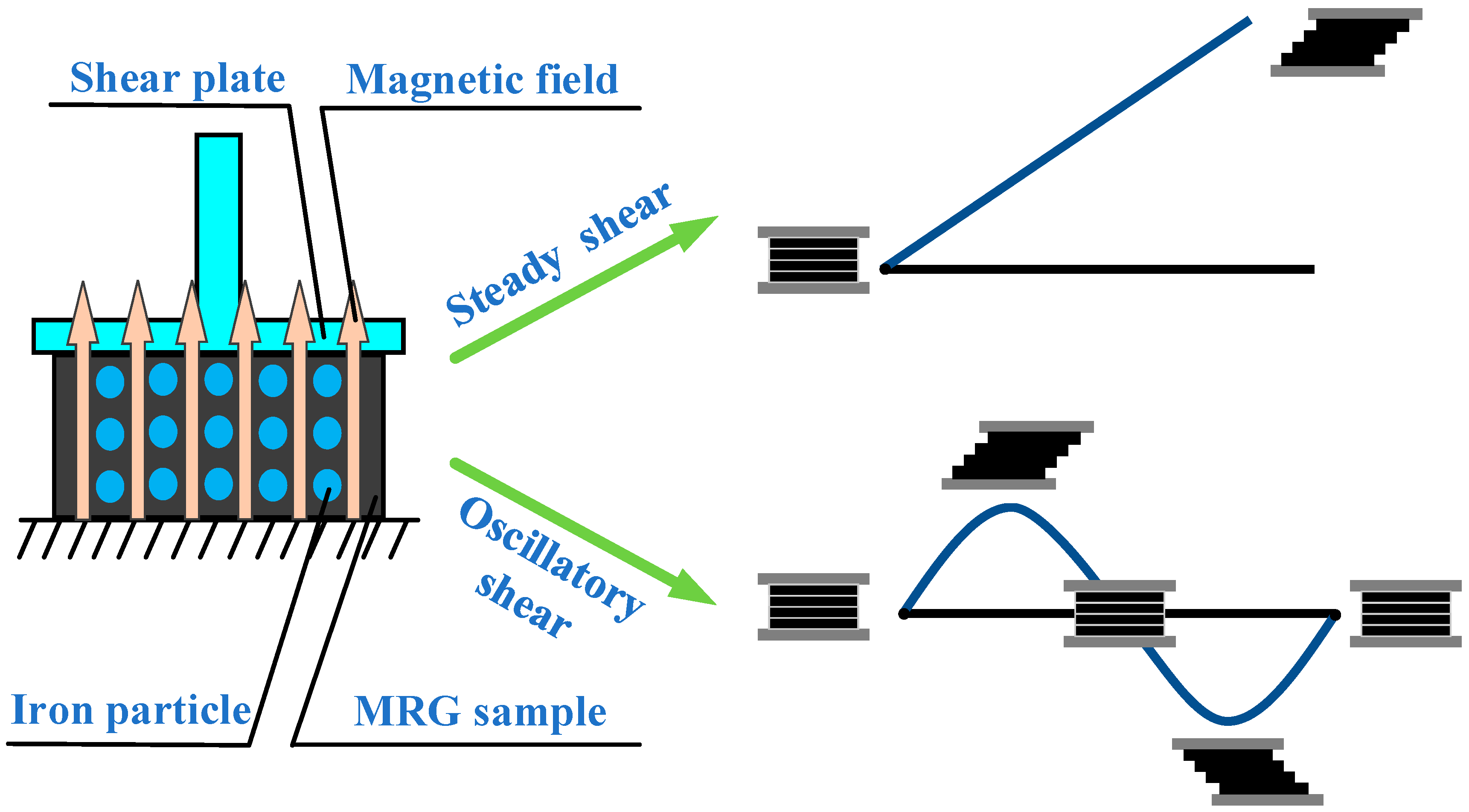
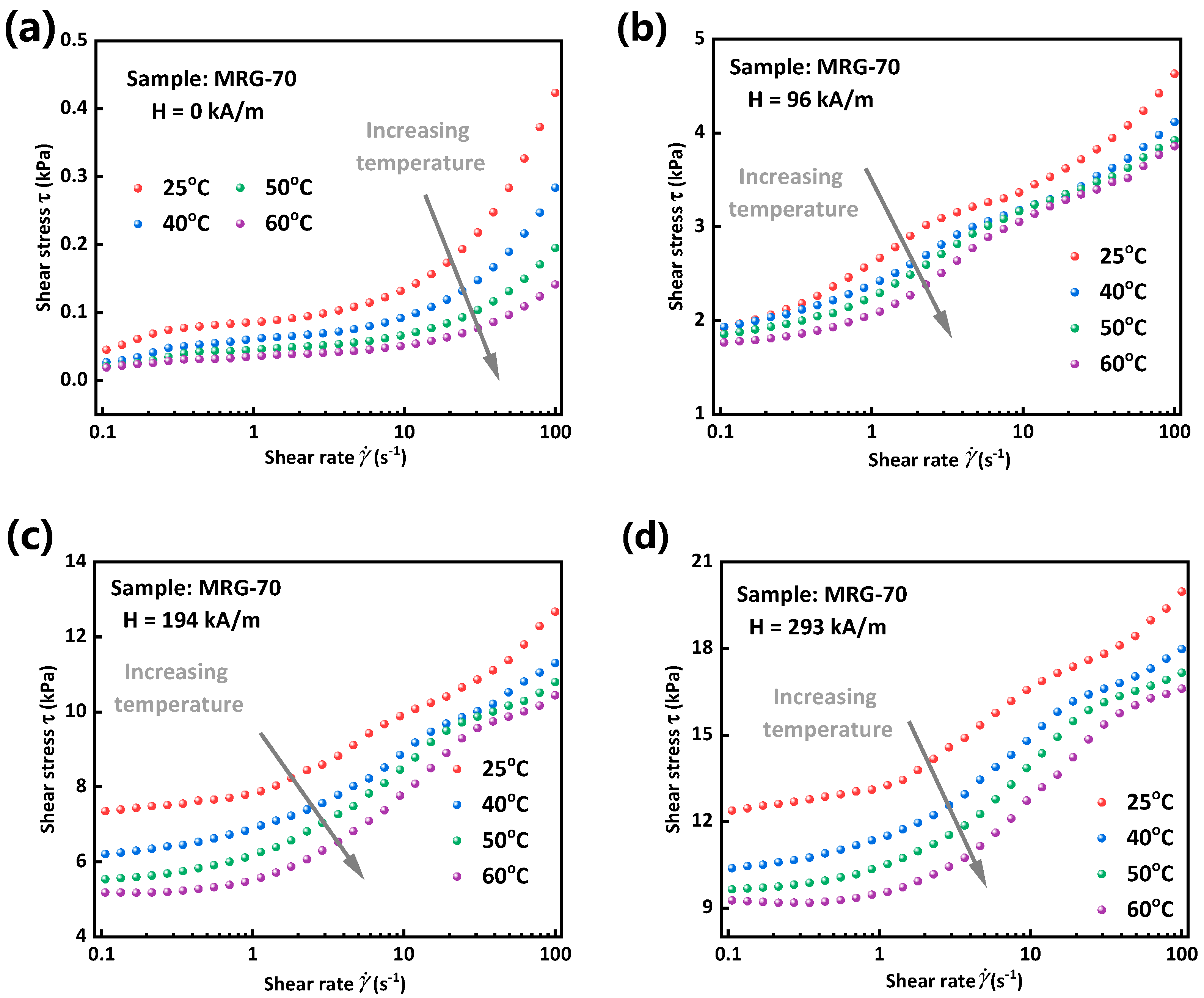
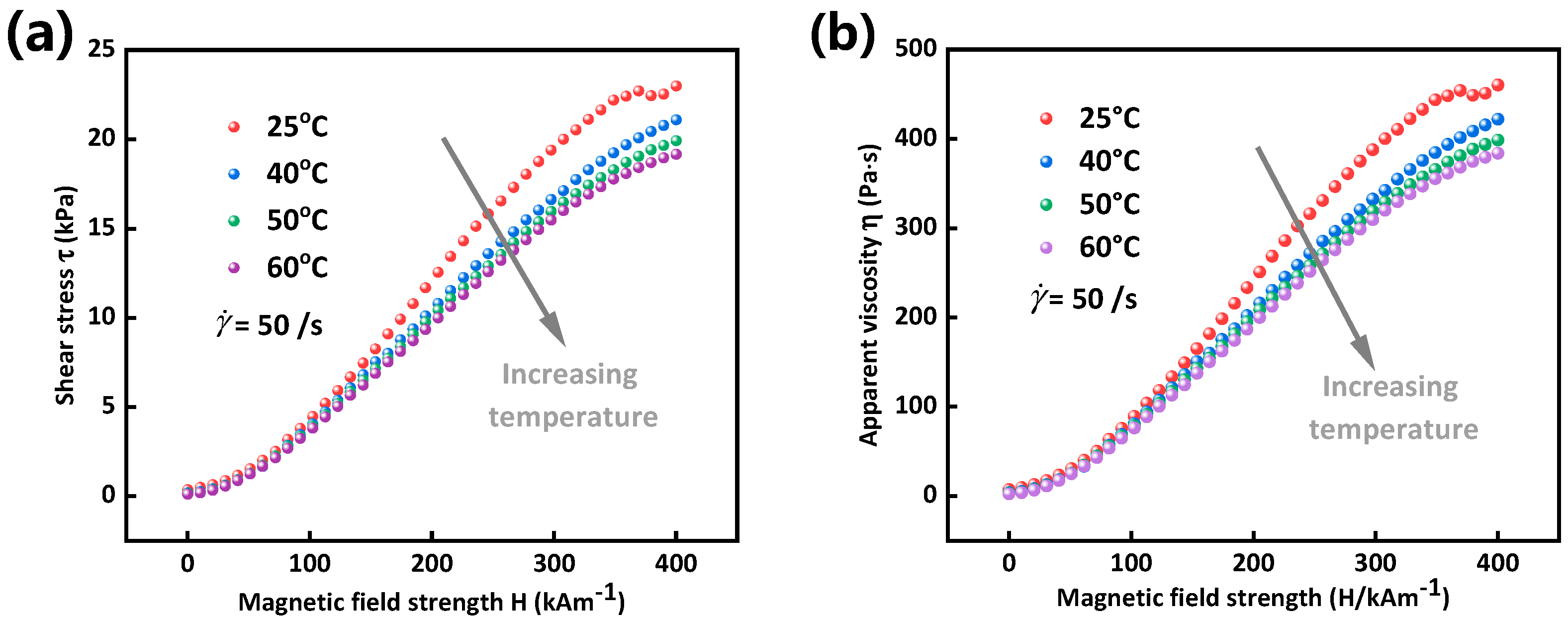


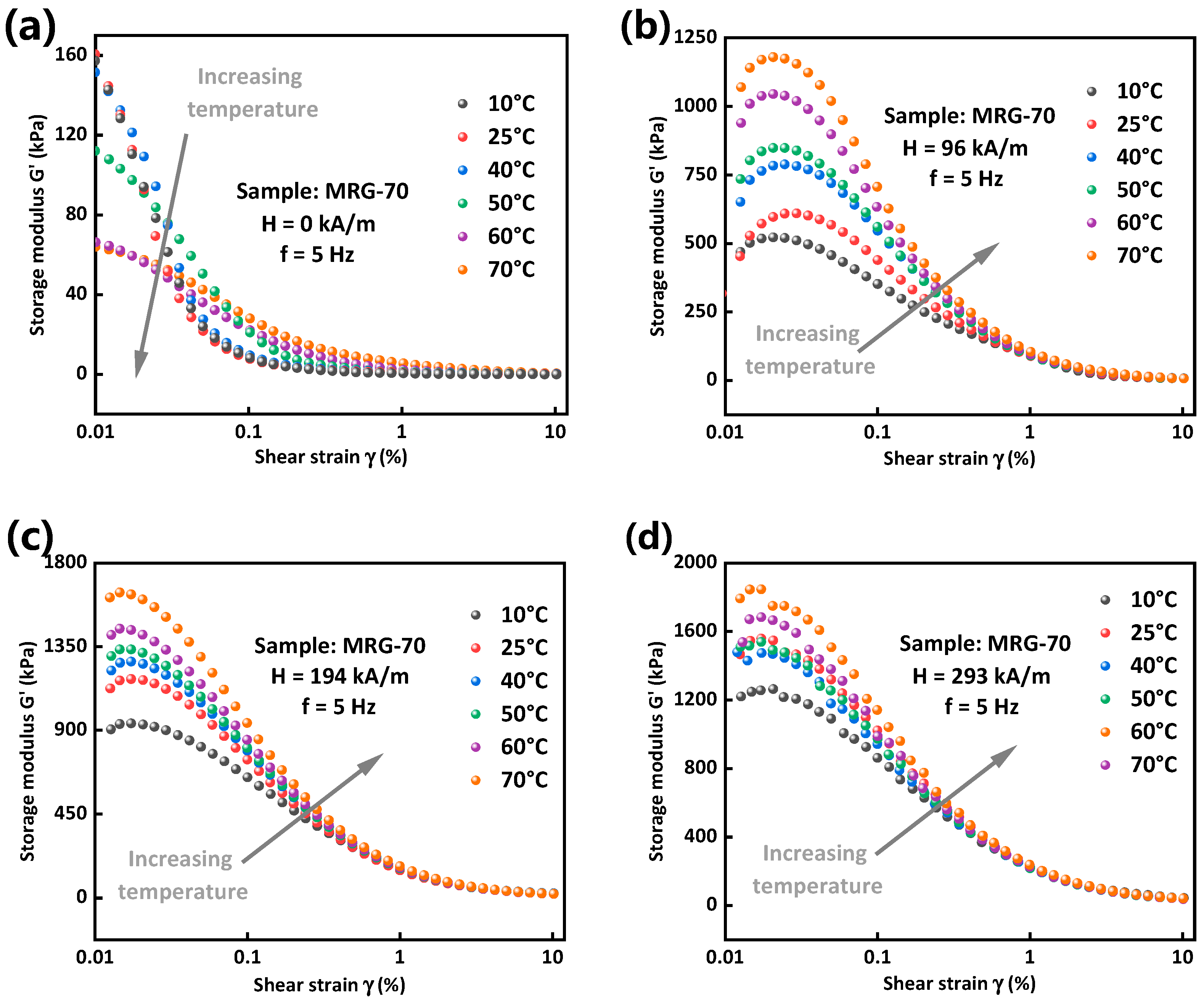
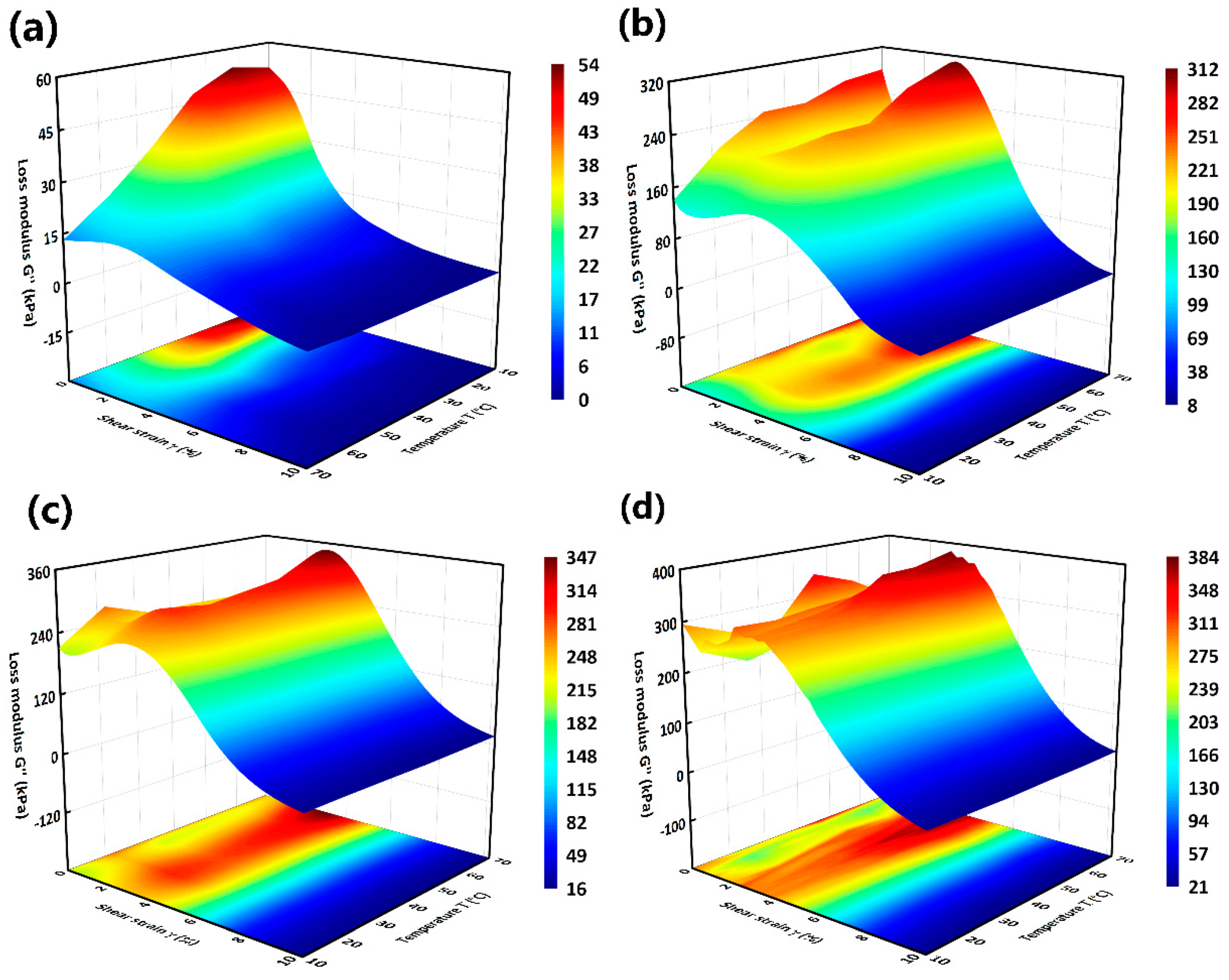
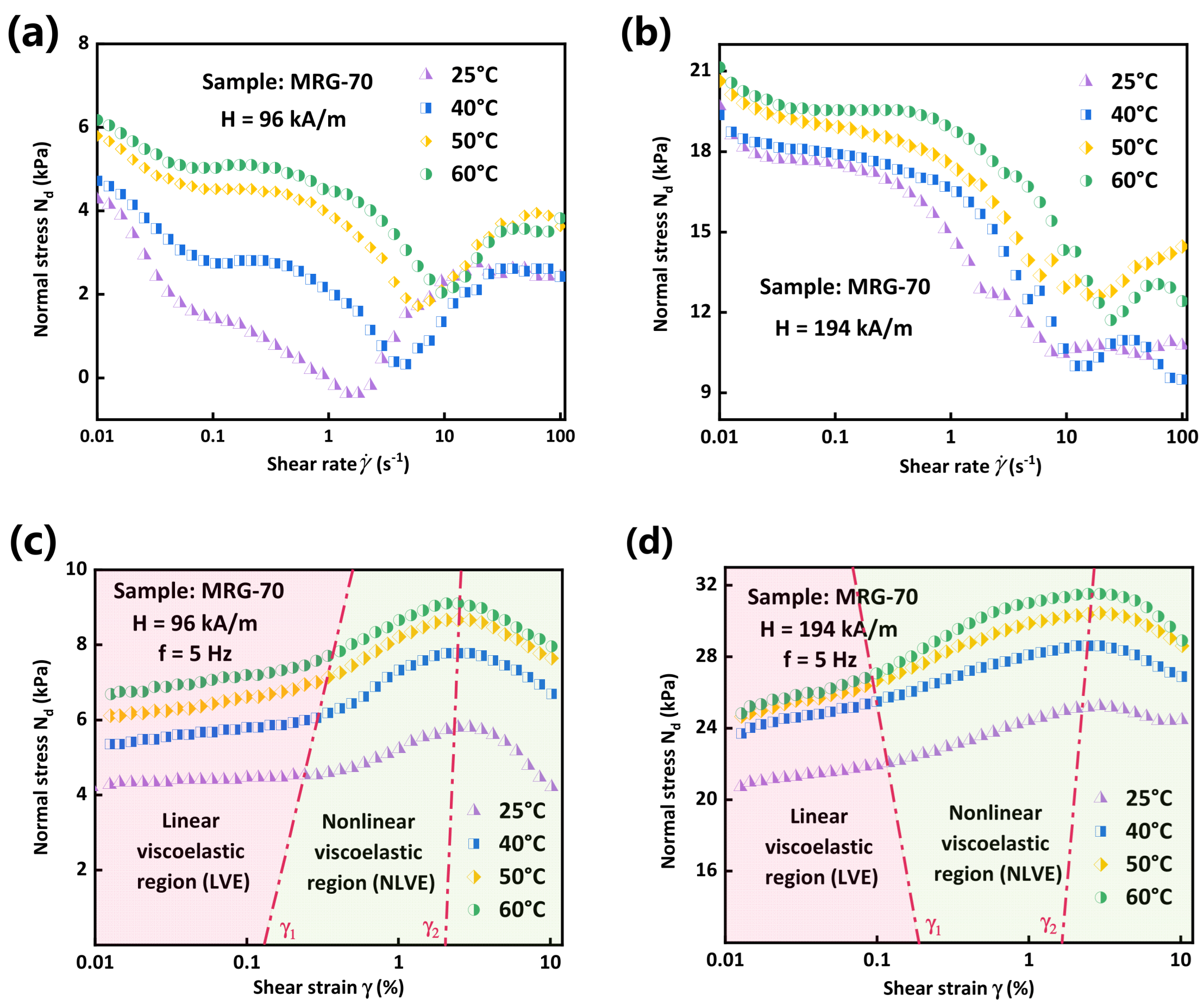
| Materials | Research Contents | Range of Temperature | Range of Magnetic Field |
|---|---|---|---|
| MRF [19] | Shear stress Storage modulus Loss modulus | 20 °C~55 °C | 0.1 T~0.5 T |
| MRF [20] | Shear stress Yield stress | 25 °C~40 °C | 0 mT~540 mT |
| MRE [21] | Storage modulus Loss modulus | 25 °C~60 °C | 0 mT~500 mT |
| MRE [22] | Storage modulus Stress relaxation behavior | 20 °C~50 °C | 0 kA/m~490 kA/m |
| MRG [18] | Creep and recovery behavior | 25 °C~75 °C | 0 mT and 900 mT |
| MRG [17] | Static normal force | 20 °C~80 °C | 0 T~0.8 T |
Publisher’s Note: MDPI stays neutral with regard to jurisdictional claims in published maps and institutional affiliations. |
© 2022 by the authors. Licensee MDPI, Basel, Switzerland. This article is an open access article distributed under the terms and conditions of the Creative Commons Attribution (CC BY) license (https://creativecommons.org/licenses/by/4.0/).
Share and Cite
Sun, M.; Li, X.; Zhou, Z.; Deng, R.; Chen, X.; Wang, J.; Mao, R. Influence of Magnetic Field and Temperature on Rheological Behavior of Magnetorheological Gel. Materials 2022, 15, 8070. https://doi.org/10.3390/ma15228070
Sun M, Li X, Zhou Z, Deng R, Chen X, Wang J, Mao R. Influence of Magnetic Field and Temperature on Rheological Behavior of Magnetorheological Gel. Materials. 2022; 15(22):8070. https://doi.org/10.3390/ma15228070
Chicago/Turabian StyleSun, Min, Xiangdong Li, Zhou Zhou, Ran Deng, Xu Chen, Jiong Wang, and Runsong Mao. 2022. "Influence of Magnetic Field and Temperature on Rheological Behavior of Magnetorheological Gel" Materials 15, no. 22: 8070. https://doi.org/10.3390/ma15228070
APA StyleSun, M., Li, X., Zhou, Z., Deng, R., Chen, X., Wang, J., & Mao, R. (2022). Influence of Magnetic Field and Temperature on Rheological Behavior of Magnetorheological Gel. Materials, 15(22), 8070. https://doi.org/10.3390/ma15228070






